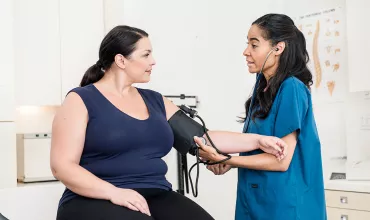Heart failure is a chronic condition where the heart muscle responsible for the pumping action weakens or stiffens over time, leaving people feeling fatigued, short of breath and at risk of sudden cardiac death1. Without effective treatment, people with heart failure will get sicker every day1. There is a need to work together to better serve people with the treatments they need to manage their heart failure and empower them to gain a sense of control over their health1,2.
ASCVD is the most common form of cardiovascular disease (CVD) and includes cardiovascular events like heart attacks and strokes3,4. High levels of low-density lipoprotein cholesterol (LDL-C), or “bad cholesterol”, in the blood increase the risk of ASCVD in many people3,4. Collaboration is vital to help solve the world’s biggest disease burdens like ASCVD by promoting the benefits of early detection and effective preventive treatment5.
A genetic risk factor affecting 1 in 5 people worldwide causes high levels of a little-known type of low-density lipoprotein known as lipoprotein(a) or Lp(a)6. People with high Lp(a) are at an increased risk of cardiovascular disease and every adult should be screened at least once in their lifetime through a simple blood test6. Understanding Lp(a) levels and associated risk can help patients and healthcare professionals have better conversations about improving heart health6,7.
IgA nephropathy (IgAN) is a progressive complement-mediated kidney disease that mostly effects young adults and is a major cause of chronic kidney disease and kidney failure worldwide8. The early stages of IgAN are often asymptomatic, meaning many people are diagnosed when they have already experienced significant kidney damage9,10. The symptoms and complications of IgAN can severely undermine people’s physical and mental health, impair their ability to work and reduce their quality of life11-16.
C3 glomerulopathy (C3G) is an ultra-rare, progressive complement-mediated kidney disease that mostly affects children and young adults17-20. Each year, approximately 1-2 people per million worldwide are newly diagnosed with C3G17. Approximately 50% of adult C3G patients progress to kidney failure within 10 years of diagnosis, at which point they will require dialysis and/or kidney transplantation19,21. Unfortunately, kidney transplants have limited success with C3G returning over 55% of people22-25. People with C3G live with devastating impacts on their day-to-day lives, from coping with the symptoms of the disease to the anxiety of possibly needing life-long dialysis or a transplant26.
Latest news
Novartis investigational atrasentan Phase III study demonstrates clinically meaningful and highly statistically significant proteinuria reduction in patients with IgA nephropathy (IgAN)
Novartis investigational iptacopan Phase III study demonstrates clinically meaningful and highly statistically significant proteinuria reduction in patients with IgA nephropathy (IgAN)
Novartis presents new long-term Leqvio® (inclisiran) data demonstrating consistent efficacy and safety beyond six years

Cardiovascular disease – By the Numbers
Cardiovascular disease (CVD) is the leading cause of death worldwide. Investment in heart health has declined for decades.

Kidney disease
The kidneys play a vital role in keeping us healthy, and often it is only when something goes wrong that we realize just how important our kidneys are.

New hope for treating inflammatory diseases of the kidney
Novartis researchers aim to preserve kidney function – and quality of life – for patients.
Resource links
Events and scientific meetings
| ACC | American College of Cardiology | https://www.acc.org/ |
| AHA | American Heart Association | https://www.heart.org/ |
| ESC | European Society of Cardiology | https://www.escardio.org/ |
| ESC-HF | European Society of Cardiology – Heart Failure | https://www.escardio.org/Sub-specialty-communities/Heart-Failure-Association-of-the-ESC-(HFA) |
| WCC | World Congress of Cardiology | https://world-heart-federation.org/world-congress-of-cardiology/ |
| EAS | European Atherosclerosis Society | https://eas-society.org/ |
| WCN | World Congress of Nephrology | https://www.theisn.org/in-action/events/world-congress-of-nephrology/ |
| ERA-EDTA | European Renal Association | https://www.era-online.org/ |
| ASN | American Society of Nephrology | https://www.asn-online.org/ |
Other therapeutic areas

Immunology
Working to create a world where the millions of people with immunological conditions, and those who treat them, can live without compromise.

Neuroscience
Creating a transformational impact for people living with severe neurological conditions and their caregivers by discovering, developing and delivering innovative medicines that change the course of disease progression.

Oncology
Combining the power of science and empathy to unravel the inner workings of cancer and develop innovative therapies that restore hope to those with cancer and their loved ones.
